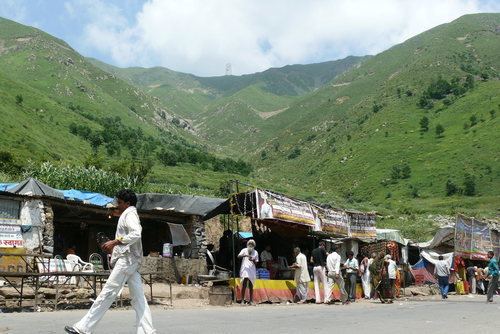Country India District Ramban PIN 182144 Elevation 1,156 m | State Jammu and Kashmir Time zone IST (UTC+5:30) Telephone Code 01998 | |
 | ||
Weather 17°C, Wind NE at 10 km/h, 44% Humidity Neighborhoods Masjid Market, Bowli Bazaar, Upper Bazaar, Mehtaab Colony | ||
Ramban is a town in the Ramban district in Indian state of Jammu and Kashmir. It is the district headquarters. It lies on the banks of the Chenab river, on the National Highway-1A (now NH44) at about 150 km from Jammu and about 150 km from Srinagar, making it almost the central point on the Jammu-Srinagar National Highway.
Contents
- Map of Ramban
- History
- Geography
- Demographics
- Gajpat Fort
- Literacy Rate
- Religion
- List of Some Hamlets in the Region
- References
Map of Ramban
History
C.E. Bats writes in his book, ‘The Gazetteer of Kashmir’, that before the formation of the J&K State in 1846, there was a small village consisting of 15 houses on the right bank of Chenab river known as Nashband (later 'Ramban'). When Raja Gulab Singh of Jammu became the Maharaja of J&K State, he adopted Jammu-Udhampur-Banihal route to reach Srinagar for the movement of royal carvans. In this process, Ramban got the status of halting station for the royal Carvans. The Dogras constructed a pacca building near present Ramban and a wooden bridge for the crossing of Chenab River. Sukhdev Singh Chadak writes in his book ‘Maharaja Ranbir Singh’ that Maharaja passed order for a cart road from Jammu to Srinagar via Banihal and a suspension bridge over Chenab River at Ramban. This road became national highway and now it is being converted into four lanes. With the development of this road, the halting station Ramban also developed a lot and now it has got the status of district headquarters.
Geography
Ramban district has an average elevation of 1,156 metres (3792 feet). The boundary lines of Ramban district have come to be drawn from Patnitop on its south, Assar on its east, Gool on its west and Banihal on its north. Ramban district comprises two Tehsils, namely, Ramban and Banihal, and four community development blocks, namely, Banihal, Gool, Ramban and Ramsoo. The district consisted of 116 census villages and 127 Revenue villages in 2001. Total panchayat Halqas in District Ramban are 124.
Demographics
This data is referred to the Ramban town. For its namesake district, see 'Ramban district'
As of 2011 India census, Ramban town had a population of 3,596 of which 1,873 are males while 1,723 are females.
Literacy rate of Ramban town is 82.23%. In Ramban, Male literacy is around 90.42% while female literacy rate is 73.52%.
Gajpat Fort
There is an important fort known as Gajpat Fort, on the top of mountain. It is said that once Sheikh Abdullah was kept imprisoned in this fort for few days. In 1825, Gulab Singh had imprisoned Raja Sultan Khan of Bimbar in this fort. Sultan Khan died there and was buried at Chanderkote. In 1858 Mean Hathu Singh, the Governor of Rajouri and a closed relatives of Maharaja had revolted against State Government and tried to kill Maharaja Ranbir Singh. Mean Hathu was arrested and shifted to Gajpat fort.
Literacy Rate
Religion
Muslims 70.68%,
Hindu 28.56%,
Sikh 0.27%,
Christian 0.15%
Hindu 56.70%,
Muslim 41.46%,
Christian 1.11%,
Sikh 0.53%
